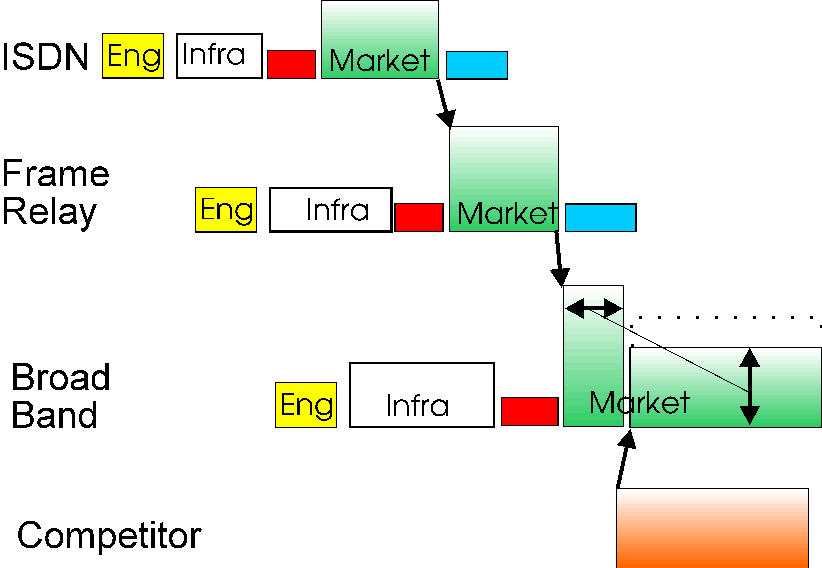 Waves Of Technology
Waves Of Technology Waves Of Technology
Waves Of TechnologyA good example of the need for program management is in a telecommunications service company. It used to be that a new communications technology would come along every twenty years or so. The old equipment was reaching the end of its life, it had been amortised to nothing, the telco would gear up to introduce the new stuff, train its staff, and then wait for the next wave. That was then. Now, the waves come at ever shorter intervals, a new technology hardly being introduced before it is already obsolete.
There are new ways of using the communications infrastructure that were not envisaged when it was built - high speed modems, online banking, purchasing goods over the net, video telephony in the medium term. On top of that, the deregulation and privatisation of telecommunications has brought a new competitiveness to the area
As an example, we need to plan the introduction of three waves of communications technology, viz.
ISDN
Frame Relay
Broad Band or Full Service Network
In simplified form, each technology has activities for engineering, infrastructure, market development, market operation, and market closeout. Each new wave will cannibalise the market of its predecessor. We need to be able to control the existence of individual activities, projects and clusters of projects in the plan.

With deregulation, the telco's strategy may be complicated by a competitor who has no investment in the previous waves of technology. The telco can stick to the usual pattern, which allows the competitor to grab a larger share of the lucrative broad band market by being first, or head off the competitor and either waste investment in preceding waves, or skip a wave altogether.
The durations of the market activities are linked, so moving the Frame Relay project back reduces the length of the ISDN market activity, reducing the return on that project.
For broad band cable, there is an initial large market if you are first to market, and the final market share is dependent on how much earlier than the competitor you entered the market. If you delay your introduction until after the competitor, your long term market share is reduced, even though you obtained better returns on previous technology investments.
Each new infrastructure investment is usually larger than the last, and the resulting market is usually many times larger than the last.
The CRM plan uses activities and groups of activities which can be turned on and off, a resource usage (market share) which is some function of the duration of a preceding activity, and activities with durations dependent on relative starting times of other activities.
The planner can estimate the entry of the competitor in the market, then use the model to explore options in terms of the organisation's projects, and the potential cashflows and capital flows that might result from different combinations. The planner cannot avoid modelling at least some of the business needs, because it is these needs which drive the interactions among the various projects as they compete both for resources and for survival.
Just as CPM allows the planner to build up a formalised project plan that is too detailed to be held in one's head, CRM allows the planner to build up a detailed plan having all the interactions and external influences on the project program. If the model then doesn't behave in the way the planner expected, the plan can be changed or the way the planner thinks about the plan can change.
What used to be a leisurely transition between Strategic Planning and Project Management has now been telescoped into a layer of Program Management because of the shorter timescales and greater risk. The simple tools adequate for planning sequential projects provide little support for this new layer of decision making. Constraint Reasoning, with its alternatives and contingencies and financial analysis, can bring some or all of the business needs of the telco into the Program Management plan.